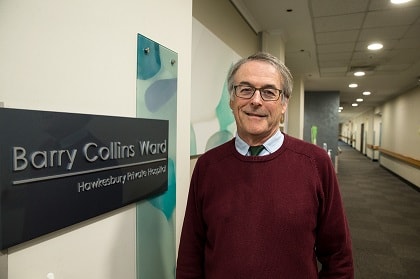Re-thinking lateral hip pain in ageing patients
Hawkesbury Orthopaedic Surgeon Dr Michael Walsh explains how lateral hip pain which has always been thought of as trochanteric bursitis, is actually mostly due to hip tendon degeneration. Although it commonly requires surgical reconstruction, surgery can reliably and effectively relieve the symptoms.
9 Jun 2020

The spontaneous onset of lateral hip pain in the over fifties is most commonly diagnosed as trochanteric bursitis. Recent improvements in our understanding of this condition confirm it is actually a problem of the underlying tendons which is why treatment of the bursa alone often results in only short-term pain relief, says Dr Michael Walsh , Orthopaedic Surgeon at Hawkesbury Hospital.
“Trochanteric or ‘lateral hip’ pain is rarely due to bursitis,” said Dr Walsh. “True trochanteric bursitis is actually quite a rare problem and is more often seen in young athletes. In the older patients who may have been diagnosed with bursitis but are not responding to physiotherapy or cortisone injections, it is important to consider the possibility of degenerative tendon disease.
“Trochanteric bursitis has always been considered a chronic and intractable condition. Improved understanding of the problem has changed this. When physiotherapy, chiropractic treatment and Cortisone injections don’t relieve symptoms, the problem is almost certainly separation of the tendons from their bony attachment.
“Much like Plantar Fasciitis, which is similarly not an inflammation problem, but a degenerative condition, the tendons separate from the bone due to normal wear and tear causing mechanical symptoms such as pain with walking or when lying on the affected side. It is also important not to think of it as hip arthritis, which is a very different problem.”
Gluteal tendon degeneration does not improve with time or exercise but is slowly and progressively incapacitating. It produces a gait that is often described as a waddle by family members and pain on the lateral side of the thigh – caused by the separated tendons rubbing on the bone. This results in considerable incapacity with reduced mobility and eventually the need to use a walking stick.
A successful gluteal tendon reconstruction to reattach the pair of tendons involved can provide sufferers with dramatic and substantial pain relief because it deals directly with the problem. At surgery, the tendons are exposed and the damaged area removed, leaving a clean healthier tendon surface. After also preparing the bone surface, the tendons are reattached with large sutures passed through multiple tunnels in the bone. Recovery is about six to twelve weeks post-operatively depending on duration of symptoms.
Dr Walsh is known nationally and internationally for his work in this field and has successfully completed more than a thousand hip tendon procedures at Hawkesbury Hospital over many years.
“Patients come from all over the country to have this procedure done at Hawkesbury,” he said. “We have an excellent team here at Hawkesbury because we have been working together for a very long time and have established a good understanding of each member’s role. We are offering world-class surgery at Hawkesbury Hospital, and I’m proud of the level of surgical care we provide.”
Dr Walsh's findings were recently published in the peer reviewed Journal of Arthroplasty.
You may be interested in

